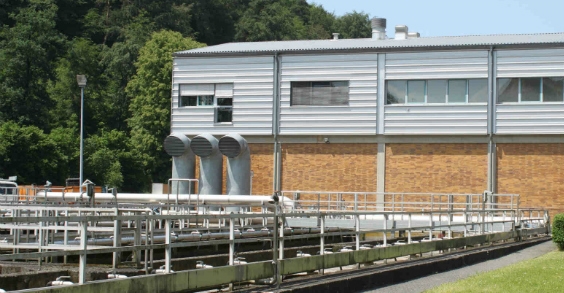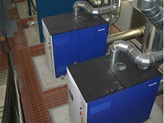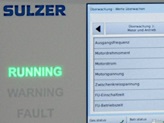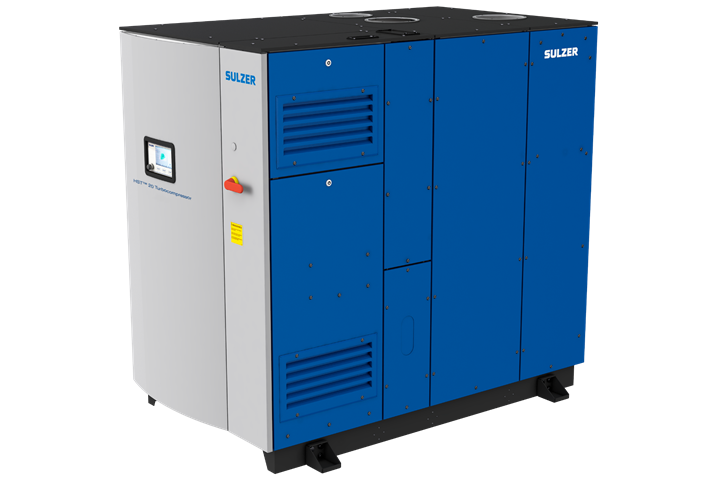-
HST™ turbocompressorThe modern and silent HST™ turbocompressor features an advanced design with proven magnetic bearing technology and a high-speed motor driven through a built-in frequency converter.
Sulzer's solution cuts operating costs in wastewater treatment
Sulzer turbocompressor - important building block in energy neutral sewage plant
The electricity supply also includes the operating and administrative building for 200 employees and the “refueling” of the electric vehicles operated by the sewage treatment plant. Neither the stable performance nor the values of the wastewater treatment process have been affected. On the contrary, the treatment results have improved significantly. The monitoring values for the nitrogen parameter have been reduced by 20 percent.
The challenge
Energy optimization
The optimization took place step by step and started with the largest energy consumer of the wastewater treatment plant, the biological treatment stage. Updating the aeration system was essential. The goal was a reduction of 20% in the energy demand with a simultaneous increase in the treatment performance.
The previous system with cascades and upstream denitrification stages was replaced. A highly energy-efficient plate aeration system with plug flow was taken into use. This provides circulation by short-term pulse aeration with intermittent nitrogen elimination and alternating aeration. Three aeration tanks operate as reactors and are aerated with oxygen only when needed. The carbon concentration is sufficient for denitrification. There was no need to use the existing 42 agitators.
The three basins have different depths. They are aerated by two turbocompressor groups. The air volume of one compressor group is between 1'500 and 10'500 Nm3/h at a pressure of about 450 mbar. The air volume of the other compressor group is between 2'000 and 5'000 Nm3/h at a pressure of about 650 mbar.
The solution
Sulzer turbocompressors
Three new Sulzer turbocompressors are important building blocks for the energy optimization of the aeration. They complement two existing PD blower assemblies, which covered the lower power range with low air volumes until the installation of the HST turbocompressors that, in turn, replaced two older turbocompressors. Studies and evaluations showed that there still was a significant savings potential. In particular the air volumes could be adapted even more accurately to the respective demand. Consequently, the old turbocompressors were replaced with new HST turbocompressors in mid-2015.
The information provided by the individual manufacturers on the power consumption of an average „sewage treatment day" was critical for us. In the inquiry, we had given them 12 time slices with different requirements for the operating points (air volume and system pressure). When comparing the operating costs based on this information, Sulzer‘s solution turned out to be the best for cutting the operating costs. Before the final decision was taken, the manufacturer had to prove the stated values in a test bed. The tests were made in Sulzer’s premises under specified conditions and under the supervision of the operator. After the values had been confirmed, three HST 20 turbocompressors were installed in July 2015. One unit aerates the separate basin (size 4'500 m3), the other two are for the aeration of the two connected basins (size 6'000 m3).
It was important for us to know the power supply of the compressor with all auxiliaries, not just the power consumption of the compressor itself.
Thorsten Jung
Sewage Master and Operations Manager, Stadtentwässerung Kaiserslautern
Customer benefit
By the combination of refurbishment and process optimization, a 50% reduction in the energy demand of the biological stage was achieved, while the treatment performance increased simultaneously thanks to a 20 percent reduction of the nitrogen parameters.
With today‘s promise from the manufacturer, i.e. shipping of common sizes of the turbocompressor within 36 hours from the order, this installation would have given further savings through faster commissioning. The installation and commissioning took place during operation and lasted for about four months. Sulzer’s specialists made the initial commissioning and taught the employees how to operate the turbocompressors in about two hours. Subsequently, the electronic control was optimized in two stages. The new turbocompressors cover the whole range of the required air volumes. The two PD machines are now only used as a back-up in case of a possible disturbance.
From the operator‘s point of view, certain design features of the new compressors stand out. The magnetic bearing allows arbitrary on/off cycles without particularly stressing the machine. For the same reason the compressor operates almost maintenance-free. In operation, the visualization of the performance data directly at the compressor has proved to be advantageous, because the operating conditions can be viewed directly. Also the arrangement of the suction and discharge nozzles is favorable, since a simple pipe guidance is possible. Furthermore, the compressors are very quiet. Finally, the fast and competent support as well as the service of the manufacturer were very valuable.
In addition to the use of energy-efficient turbocompressors, the precise control and adjustment play a major role in saving energy. The Sulzer machine can be adjusted exactly. Here too, the magnetic bearing is an important detail, as it allows for a fully flexible operation. The regulation is based both on an air requirement and on air distribution. The measured values of online meters at the supply and drainage of the biogas basins and 22 oxygen probes provide the input data. The goal is to regulate as little as possible with valves and as much as possible directly at the turbocompressor.
According to the calculations of the operator, the investment will be amortized in less than five years. The expected lifetime of the maintenance-free turbocompressors with magnetic bearings is about 15 years. An additional advantage comes from the possibility to allocate the investment costs to the wastewater discharge due to the fact that the cleaning performance has improved.
The sewage treatment plant Kaiserslautern is one of the first plants of this size that is energy neutral without using co-substrates. Through a subsidiary, WVE GmbH Kaiserslautern, it offers its knowledge and experience for the energy optimization of other sewage treatment plants.



